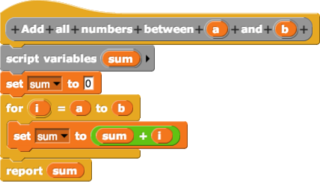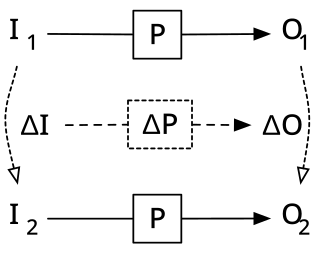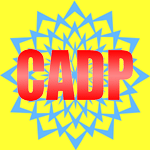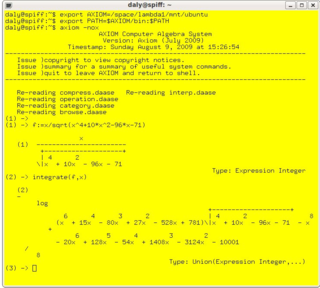Related Research Articles
A computer algebra system (CAS) or symbolic algebra system (SAS) is any mathematical software with the ability to manipulate mathematical expressions in a way similar to the traditional manual computations of mathematicians and scientists. The development of the computer algebra systems in the second half of the 20th century is part of the discipline of "computer algebra" or "symbolic computation", which has spurred work in algorithms over mathematical objects such as polynomials.

In computer science, model checking or property checking is a method for checking whether a finite-state model of a system meets a given specification. This is typically associated with hardware or software systems, where the specification contains liveness requirements as well as safety requirements.
Axiom is a free, general-purpose computer algebra system. It consists of an interpreter environment, a compiler and a library, which defines a strongly typed hierarchy.

In computing, a visual programming language, also known as diagrammatic programming, graphical programming or block coding, is a programming language that lets users create programs by manipulating program elements graphically rather than by specifying them textually. A VPL allows programming with visual expressions, spatial arrangements of text and graphic symbols, used either as elements of syntax or secondary notation. For example, many VPLs are based on the idea of "boxes and arrows", where boxes or other screen objects are treated as entities, connected by arrows, lines or arcs which represent relations. VPLs are generally the basis of low-code development platforms.
In computer science, a binary decision diagram (BDD) or branching program is a data structure that is used to represent a Boolean function. On a more abstract level, BDDs can be considered as a compressed representation of sets or relations. Unlike other compressed representations, operations are performed directly on the compressed representation, i.e. without decompression.
In computer science, symbolic execution (also symbolic evaluation or symbex) is a means of analyzing a program to determine what inputs cause each part of a program to execute. An interpreter follows the program, assuming symbolic values for inputs rather than obtaining actual inputs as normal execution of the program would. It thus arrives at expressions in terms of those symbols for expressions and variables in the program, and constraints in terms of those symbols for the possible outcomes of each conditional branch. Finally, the possible inputs that trigger a branch can be determined by solving the constraints.
Datalog is a declarative logic programming language. While it is syntactically a subset of Prolog, Datalog generally uses a bottom-up rather than top-down evaluation model. This difference yields significantly different behavior and properties from Prolog. It is often used as a query language for deductive databases. Datalog has been applied to problems in data integration, networking, program analysis, and more.
ALTRAN is a programming language for the formal manipulation of rational functions of several variables with integer coefficients. It was developed at Bell Labs in 1960s. ALTRAN is a FORTRAN version of ALPAK rational algebra package, and “can be thought of as a variant of FORTRAN with the addition of an extra declaration, the ‘algebraic’ type declaration.”
A bigraph can be modelled as the superposition of a graph and a set of trees.
Symbolic Manipulation Program, usually called SMP, was a computer algebra system designed by Chris A. Cole and Stephen Wolfram at Caltech circa 1979. It was initially developed in the Caltech physics department with contributions from Geoffrey C. Fox, Jeffrey M. Greif, Eric D. Mjolsness, Larry J. Romans, Timothy Shaw, and Anthony E. Terrano.
A structure editor, also structured editor or projectional editor, is any document editor that is cognizant of the document's underlying structure. Structure editors can be used to edit hierarchical or marked up text, computer programs, diagrams, chemical formulas, and any other type of content with clear and well-defined structure. In contrast, a text editor is any document editor used for editing plain text files.

Incremental computing, also known as incremental computation, is a software feature which, whenever a piece of data changes, attempts to save time by only recomputing those outputs which depend on the changed data. When incremental computing is successful, it can be significantly faster than computing new outputs naively. For example, a spreadsheet software package might use incremental computation in its recalculation features, to update only those cells containing formulas which depend on the changed cells.

CADP is a toolbox for the design of communication protocols and distributed systems. CADP is developed by the CONVECS team at INRIA Rhone-Alpes and connected to various complementary tools. CADP is maintained, regularly improved, and used in many industrial projects.

In mathematics and computer science, computer algebra, also called symbolic computation or algebraic computation, is a scientific area that refers to the study and development of algorithms and software for manipulating mathematical expressions and other mathematical objects. Although computer algebra could be considered a subfield of scientific computing, they are generally considered as distinct fields because scientific computing is usually based on numerical computation with approximate floating point numbers, while symbolic computation emphasizes exact computation with expressions containing variables that have no given value and are manipulated as symbols.
Louis Hodes was an American mathematician, computer scientist, and cancer researcher.
Massachusetts Computer Associates, also known as COMPASS, was a software company founded by Thomas Edward Cheatham Jr. and based in Wakefield, Massachusetts from approximately 1961 to 1991, focusing primarily on programming language design and implementation, especially source-to-source transformation. It was acquired in the late 1960s by Applied Data Research.
Neuro-symbolic AI is a type of artificial intelligence that integrates neural and symbolic AI architectures to address the weaknesses of each, providing a robust AI capable of reasoning, learning, and cognitive modeling. As argued by Leslie Valiant and others, the effective construction of rich computational cognitive models demands the combination of symbolic reasoning and efficient machine learning. Gary Marcus argued, "We cannot construct rich cognitive models in an adequate, automated way without the triumvirate of hybrid architecture, rich prior knowledge, and sophisticated techniques for reasoning." Further, "To build a robust, knowledge-driven approach to AI we must have the machinery of symbol manipulation in our toolkit. Too much useful knowledge is abstract to proceed without tools that represent and manipulate abstraction, and to date, the only known machinery that can manipulate such abstract knowledge reliably is the apparatus of symbol manipulation."
References
- ↑ Carlos Christensen: Examples of Symbol Manipulation in the AMBIT Programming Language. in ACM'65: Proceedings of the ACM '65 conference. 1965, pp. 247-261.
- ↑ Carlos Christensen: On the implementation of AMBIT, a language for symbol manipulation. Communications of the ACM, Volume 9 Issue 8, 1966
- ↑ Michael S. Wolfberg: Fundamentals of the AMBIT/L list-processing language, Proceedings of the symposium on two-dimensional man-machine communication. October 1972
- ↑ Carlos Christensen: An Example of the Manipulation of Directed Graphs in the AMBIT/G Programming Language, in Melvin Klerer et al: Interactive Systems for Experimental Applied Mathematics, Academic Press, 1968, pp. 423-435.
- ↑ P. D. Rovner, D. A. Henderson: On the implementation of AMBIT/G: a graphical programming language, Proceedings of the 1st international joint conference on Artificial intelligence, ACM, 1969
- ↑ Brad A. Myers: Taxonomies of visual programming and program visualization, Journal of Visual Languages & Computing, Volume 1, Issue 1, March 1990, pp. 97-123
- ↑ Carlos Christensen, Michael Karr: IAM, a system for interactive algebraic manipulation. Proceedings of the second ACM symposium on Symbolic and algebraic manipulation. ACM, 1971